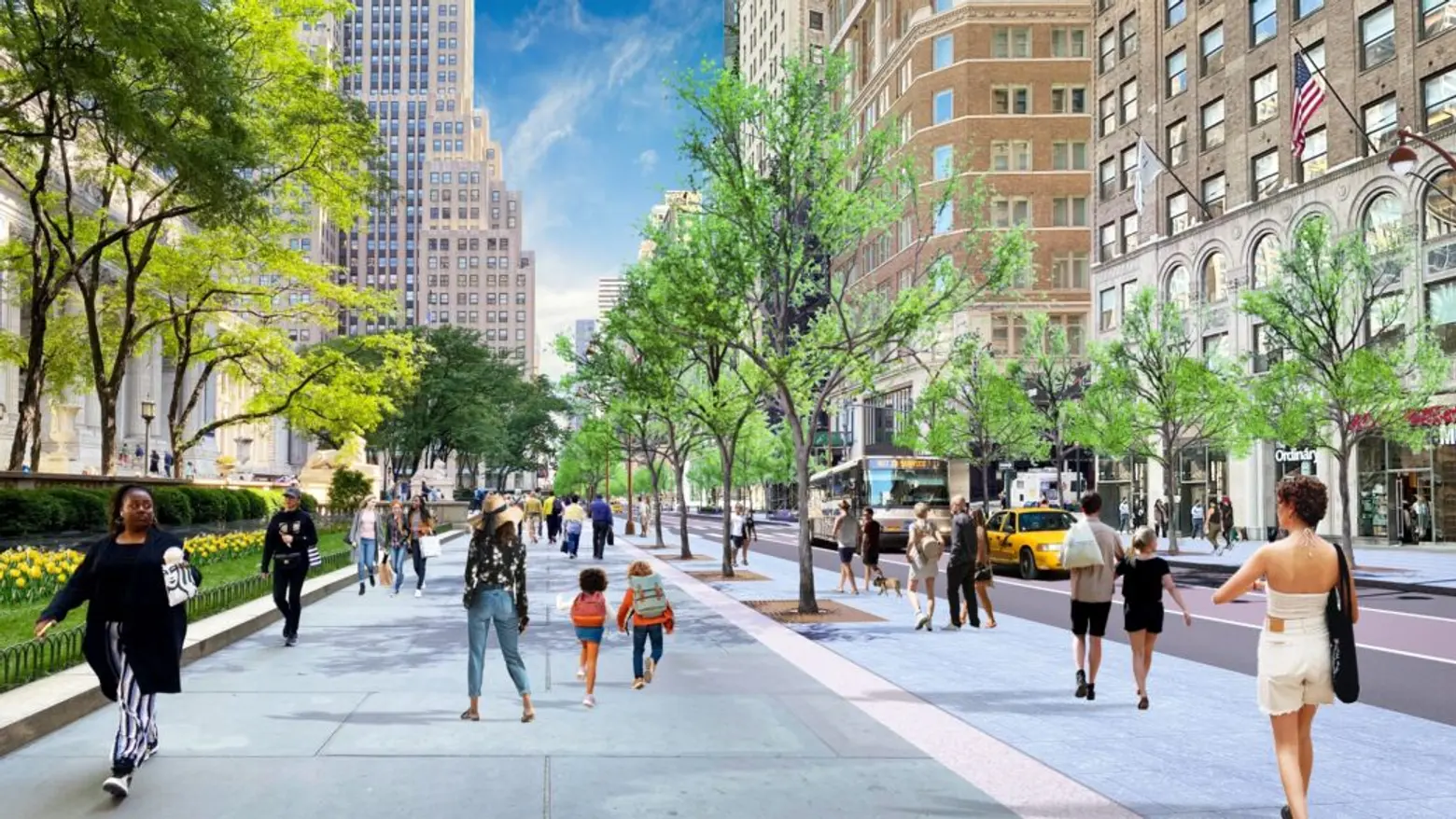See the plan to transform Fifth Avenue into premier, pedestrian-friendly corridor

Images courtesy of City Hall
Here’s a peek at what a pedestrian-friendly Fifth Avenue could look like. Mayor Eric Adams on Thursday revealed a proposed redesign of the iconic thoroughfare between Bryant Park and Central Park into a pedestrian-focused corridor by cutting the number of traffic lanes from five to three, nearly doubling the width of sidewalks, shortening crosswalks, and planting more than 200 trees. The $350 million project, the first major alteration to Fifth Avenue in its 200-year history, aims to turn the boulevard into a grand shopping street, akin to the Champs-Élysées in Paris and Ginza in Tokyo.

“As we celebrate the 200th anniversary of one of the most famous streets in the world, New Yorkers can look forward to a brand-new Fifth Avenue that will return the street to its former glory as a pedestrian boulevard,” Madelyn Wils, interim president, Fifth Avenue Association, and co-chair, Future of Fifth Steering Committee, said.
“Reversing the century-old trend of putting cars first, this visionary design will transform our overcrowded avenue into a spacious and green corridor for shoppers and workers, visitors and New Yorkers, and everyone on Fifth.”
Fifth Avenue currently measures 100 feet wide, with five lanes of traffic and two 23-foot-wide sidewalks. Despite pedestrians making up 70 percent of all traffic on the avenue, sidewalks only account for 46 percent of the space.
Each block sees about 5,500 pedestrians per hour on average, rising to as many as 23,000 people an hour during the holiday season—equivalent to “Madison Square Garden at maximum capacity, plus 4,000 more,” according to officials.
The corridor’s current layout can’t handle heavy pedestrian traffic, with only 15 feet of unobstructed sidewalks on either side. The remaining space is taken up by things like signage, bus stops, lighting, and trash cans.

The proposed design nearly doubles the width of the sidewalks to 33.5 feet each, expands unobstructed walking space to 25 feet on each side, and adds another 8.5-foot-wide portion for trees. These changes hope to improve pedestrian safety by reducing crossing lengths by more than a third.
The redesign includes more than 230 new trees and 20,000 square feet of planters, new seating and activation space, enhanced lighting, and more.
With more tree coverage, Fifth Avenue will be better protected against heat, and a new stormwater system will be installed to combat flooding.


The design draws inspiration from the area’s historic landmarks and their Art Deco influences, while also borrowing from the redesigns of other iconic retail corridors like the Champs-Élysées in Paris and Oxford and Regent Streets in London.
“People across the globe identify Fifth Avenue as a premier destination for strolling and shopping. But its larger-than-life reputation means that its sidewalks have reached their capacity, hosting more people per hour in peak seasons than Madison Square Garden,” Deputy Mayor for Operations Meera Joshi said.
“By expanding sidewalks, we can turn this avenue into an iconic boulevard, a place for all, for all hours and especially for pedestrians — who can now safely stay on sidewalks rather than navigate cars to get by and through. But this isn’t only for today — it’s for tomorrow, a verdant, sustainable boulevard to grow with our city.”

A long-standing economic powerhouse of New York City, Fifth Avenue is responsible for 313,000 direct and indirect jobs, which generate $44.1 billion in wages and $11.5 billion in economic output per year.
Additionally, since Adams announced the redesign project in December 2022, the corridor has seen significant new investment in commercial renovations, record-breaking sales, and high leasing activity. Since 2023, there have been more than 10 commercial real-estate sales on the avenue, for a total of $3.9 billion.
These investments have been driven by the redesign project and its anticipated effect on revenue, along with the success of the city’s 2022 Holiday Open Streets initiative on Fifth Avenue. That year, businesses along an 11-block stretch of the corridor closed off to traffic saw an estimated $3 million in additional spending.

In 2023, Adams created the Future of Fifth public-private partnership, made up of city agencies and the Fifth Avenue Association, Grand Central Partnership, Central Park Conservancy, and Bryant Park Corporation.
The group chose the firms Arcadis, Sam Schwartz Engineering, and Field Operations to lead the design and study, and an initial design is slated for completion by the summer of 2025.
According to the New York Times, a public meeting on the plan will be held on October 29 and construction is scheduled to begin in 2028.
RELATED:
Get Inspired by NYC.
Leave a reply
Your email address will not be published.






































Very nice; but where are the bike lanes?